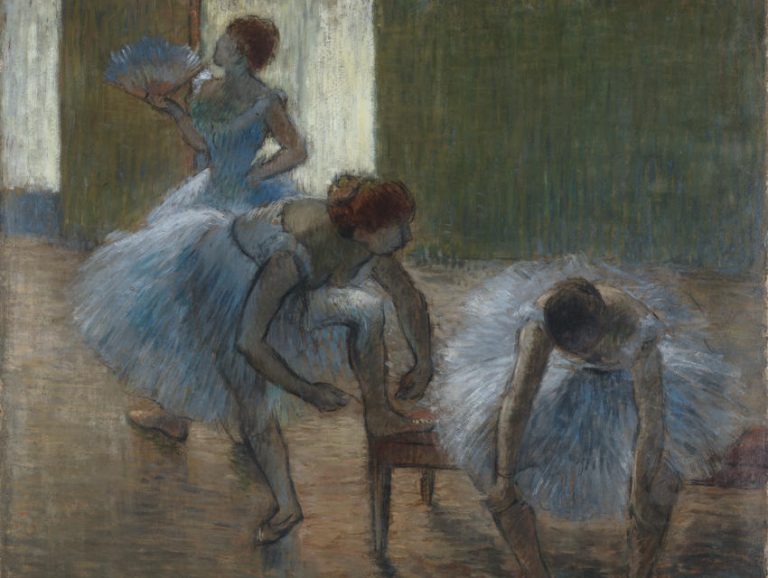We acknowledge the Traditional Owners of the land on which the Queensland Art Gallery | Gallery of Modern Art stands and recognise the creative contribution First Australians make to the art and culture of this country.

Edgar Degas / France 1834–1917 / Trois danseuses à la classe de danse (Three dancers at a dance class) c.1888–90 / Oil on cardboard / 50.5 x 60.6cm / Purchased 1959 with funds donated by Major Harold de Vahl Rubin / Collection: Queensland Art Gallery | Gallery of Modern Art
Edgar DegasTrois danseuses a la classe de danse (Three dancers at a dance class) c.1888–1890
On Display: QAG, Gallery 7
Trois danseuses à la classe de danse (Three dancers at a dance class) depicts one of Edgar Degas’s favourite themes — dancers captured in casual off-stage poses. The painting’s unusual diagonal composition was influenced by the artist’s interest in Japanese woodcut prints, popular in Paris at the time.
The bench in Degas’s painting is part of an overall scheme allowing the artist to investigate a variety of poses: a seated figure, a figure supporting a raised foot, a figure standing nearby, figures conversing. Ballet classes provided ample opportunity for Degas to study the human body — from intense activity to periods of rest.
This is a late oil painting by the artist, dating from a time when pastel was, in fact, his preferred medium.
Edgar Degas has been traditionally associated with the French Impressionists of the late nineteenth century, a group of artists who favoured new ways of recording modern life. Like many artists of his time, Degas looked to the leisure activities of the French middle class for his subject matter, which ranged from horseracing and ballet dancers to cafe and working-class scenes.
While he exhibited with the Impressionists, he was not formally part of the group and their technical innovations, which were more concerned with linear and compositional issues. Also a printmaker and sculptor, Degas’s drafting skills and delicate balance of colour ensure he is considered one of the great painters of this era.
Although he claimed disdain for Japonisme in later life, he made no secret of his admiration for Japanese prints, and was one of the first French artists to collect ukiyo-e woodblock prints in the mid 1860s.
Degas was also a keen photographer and later turned largely to sculpture. Sculpture was essentially a private and exploratory practice for Degas; he constantly remade and refined, varying poses, weight distribution and size as part of an obsessive private experiment. Upon his death, some 150 sculptures were discovered in his studio, with only around 70 complete.
Discussion Questions
1. Look at the composition of the painting. Can you see how the ballerinas appear to be in motion, although they are at rest?
2. The arrangement of the figures, as well as the placement of shapes and tones in the background, influences how the viewer’s eye moves around the work. Using your finger, trace the pattern of the movement of your eye and think about how you ‘read’ the work.
Classroom Activities
1. In pairs, take turns at being an artist’s model and an artist. As the model, pose to demonstrate a particular stance. As the artist, practise your figure drawings of a few different poses. Compare your drawings.
2. Arrange three similar objects of varying sizes and heights on a table. Use a torch or rely on natural lighting to create obvious shadows and highlights for the objects. Draw the composition, emphasising the light and shadows. Remember to include foreground and background tones.